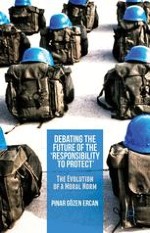
2016 | OriginalPaper | Chapter
1. Introduction
Author : Pınar Gözen Ercan
Published in: Debating the Future of the ‘Responsibility to Protect’
Publisher: Palgrave Macmillan UK
Activate our intelligent search to find suitable subject content or patents.
Select sections of text to find matching patents with Artificial Intelligence. powered by
Select sections of text to find additional relevant content using AI-assisted search. powered by